| |
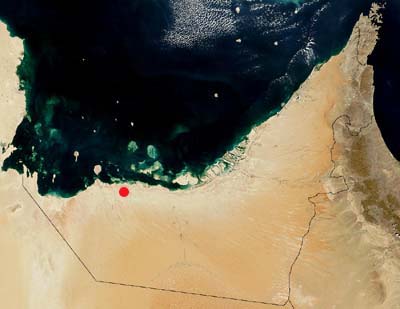
Location of Mleisa
(Source: ADIAS)
Introduction
Images
Press
Publications
Miocene period and related topics
A Proboscidean trackway in Alberta, Canada
A Mastodon trackway in Southeastern Michigan,
USA
Pleistocene mammal footprints in New Mexico,
USA
Elephant Hill trackway site, Camp Verde,
Arizona, USA
Other
websites and information on trackways
Introduction
Two sites in the vicinity of Mleisa and a third in the adjacent area
of Niqqa have recently been discovered by a team from the Abu Dhabi
Islands Archaeological Survey. We were informed about the Mleisa sites
by Mubarak Al Mansouri, Public Relations and Transport Co-ordinator
for the Jebel Dhanna terminal of the Abu Dhabi Company for Onshore Oil
Operations, ADCO. Mubarak informed us whilst work was underway by an
ADIAS team on the Late Islamic sulphur mines at Jebel
Dhanna, that he knew of a place in the desert where there were "dinosaur
tracks". Subsequent investigation of the site revealed that there
were in fact hundreds of footprints made by ancient elephants and other
animals. Preliminary examination of the rock with the footprints suggests
that it may similar in age to other rocks with the well-known Miocene
fossils, known at other sites in the Western Region, such as Jebel
Barakah, Jebel Dhanna, Ruwais
and Shuweihat. Extensive collections of
fossils have been made from a number of these sites, particularly of
proboscidean (early elephant) bones. In November 2002 and in February
2003, an ADIAS team found two fossil elephant tusks, one 2.54 metres
long and the other 1.9 metres long, at a site near Ruwais.
Following an approach by ADIAS
and by the Environmental Research
and Wildlife Development Agency, ERWDA, to H.E. Sheikh Mohammed
bin Butti Al Hamed, Chairman of the Abu Dhabi Municipality and Town
Planning Department and Ruler's Representative in Abu Dhabi's Western
Region, the Mleisa site has now been specially fenced by the Municipality.
It will now be included in the network of protected areas being developed
by ERWDA.
These sites are currently
under investigation by ADIAS.
Images
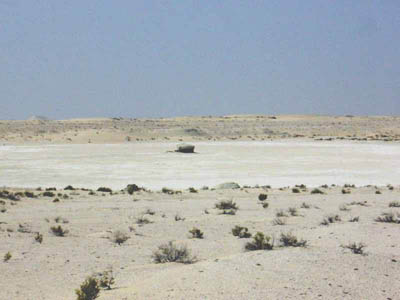
View of the main
trackway site at Mleisa (Photograph by ADIAS)
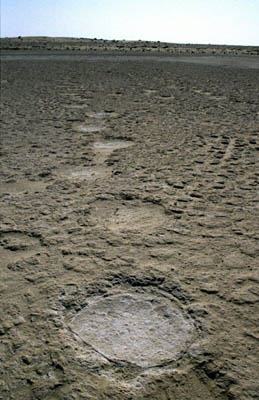
View of a part of
the proboscidean trackway at Mleisa (Photograph by ADIAS)
Press
10 December 2003 - Ancient
Elephant Footprints discovered in Abu Dhabi's Western Region (Source:
Uaeinteract.com)
Elephant footprints discovered in Western Abu Dhabi (Source: Khaleej Times)
Fossilised footprints of elephants discovered (Source: Gulf News)
 (Source: Al Bayan)
(Source: Al Bayan)
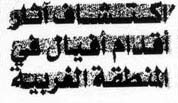 (Source: Al Fajr)
(Source: Al Fajr)
 (Source: Al Ittihad)
(Source: Al Ittihad)
 (Source: Al Khaleej)
(Source: Al Khaleej)
9 December 2003 - Ancient
Elephant Footprints discovered in Abu Dhabi's Western Region - part
1 and part
2 (Source: WAM)
30 April
2004 - Tracking
the Ancient Elephant (Source: University
of Bradford News and Views magazine - April/May
2004)
Publications
Higgs, W., A. Gardner and M. Beech. 2005. A Fossil Proboscidean Trackway
at Mleisa, Western Region of Abu Dhabi, United Arab Emirates. In: P.
Hellyer and M. Ziolkowski (eds.), Emirates Heritage Vol. 1 - Proceedings
of the 1st Annual Symposium on Recent Palaeontological and Archaeological
Discoveries in the Emirates, Al Ain. Zayed Centre for Heritage and History,
Al Ain. pp.21-27. ISBN 9948-06-130-6.
[ to download this article
in Acrobat .pdf format click here (1.2 MB) ] .
Higgs, W., A. Kirkham, G. Evans and D. Hull. 2003. A Late Miocene Proboscidean
Trackway from Mleisa, United Arab Emirates. Tribulus
(Journal of the Emirates Natural History Group)
13.2: 3-8.
[ to download this article
in Acrobat .pdf format click here (691 Kb) ] .
Miocene period and related
topics
A new look at the Mleisa footprints (Source: ADIAS
newsletter June 2002)
Late Miocene Fossils
of Abu Dhabi - visit the website,
hosted by ADIAS, which was created by Peter J. Whybrow and Andrew Hill
documenting the Natural History Museum-Yale University Abu Dhabi Miocene
Project.
La
Collecte des fossiles
The Late Miocene period in Australia and the site of Alcoota
The Miocene
epoque (University
of California Berkeley, Museum of Palaeontology)
Miocene
Mammal Mapping Project
Miocene
vertebrates from Abu Dhabi
Proboscidea
through Time
Proboscidea
- Titans of the modern land
A Proboscidean trackway
in Alberta, Canada
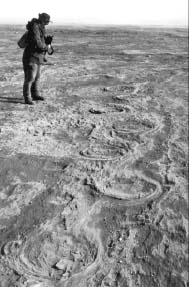
Photograph of the Mammoth trackway found by Ed Boyce, Shayne Tolman,
and Barry Wood
(Source: http://www.cseg.ca/conferences/2000/1188.PDF
- Dr Brian Kooyman, Department of Archaeology, University of Calgary,
Calgary, Alberta)
Construction of a new spillway resulted in a 10m water drop of the St.
Mary Reservoir of Alberta,Canada. This exposed fine grained aeolian
sediments and paleosols of late glacial or early Holocene age that have
been subsequently subjected to severe wind erosion. This erosion has
revealed both arich assortment of human artifacts, and the skeletal
remains of many mammals, birds, and fish. Radiocarbon dated using Accelerator
Mass Spectrometry (AMS) from the St. Mary site on selected remains,
including Bootherium bombifrons (extinct muskoxen) with an AMS
date of 10 980 ± 80 (TO-7691), Bison b. antiquus (extinct
bison) with an AMS date of 11 130 ± 90 (TO-7693) and Equus
conversidens with and AMS date of 11 330 ± 70 (TO-7696) indicates
an age of 11 000 to 11 300 years before present for the St. Mary site.
Furthermore, activity of the vertebrate fauna within the study area
is shown by extensive trace fossils including many burrows and by the
tracks of camelids (Camelops hesternus), equids (Equus conversidens),
and bovids. A well preserved trackway allows the identification of the
largest member of the St. Mary fauna.The trackway consists of a series
of nine well preserved tracks, arranged in a symmetrical, staggered,
even spaced pattern, stretching over 11m. The tracks are circular to
slightly ellipsoidal in shape with a diameter 55 to 70cm. They consist
of concentric rings of sediment pushed up while the animal walked on
soft muddy ground. The innermost ring of St. Mary tracks represents
the true foot impression and has a diameter of 45cm, suggesting a mature
female or immature male. The average stride length of 2.4m is consistent
for a modern elephant with a shoulder height of approximately 2.5m walking
at slow speed, which would be expected in the soft conditions that existed
at the time. The large size of the tracks, their circular to ellipsoid
shape, and the estimated shoulder height, indicate that only a proboscidean
would have been capable of their production. Mammuthus primigenius
is assigned as the probable maker, being the most common Proboscidean
in Southern Alberta, though M. columbi may have been present.
Figure showing mammoth trackway found by Ed Boyce, Shayne Tolman, and
Barry Wood.
References:
Hills, L.V., P.E. McNeil,
and S. Tolman 1999. First reported Canadian proboscidean trackway from
the St. Mary Reservoir, Alberta, Canada. Journal of Vertebrate Paleontology
19, suppl. to (3): 51A.
McNeil, P.E., and Hills, L.V. (mcneil@geo.ucalgary.ca, Dept. Geol. &
Geoph., Univ. Calgary); Kooyman, B. (Dept. Arch., Univ. Calgary); and
Tolman, S., (Dept. Res. & Env., Univ. Calgary, 2500 University Drive
NW, Calgary, AB, T2N 1N4). 2000. First
reported Canadian Proboscidean trackway from the St. Mary Reservoir,
Alberta, Canada.
A Mastodon trackway in
Southeastern Michigan, USA
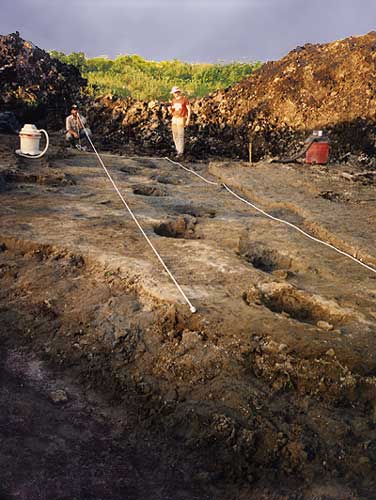
Mastodon trackway at the Brennan site near Saline, Michigan, USA
(Source: University
of Michigan Exhibit Museum of Natural History)
Mastodon
trackway - about the set of preserved mastodon footprints found
at the Brennan
site near Saline, Michigan. There is a cast of the trackway on the
third floor of the University
of Michigan Exhibit Museum of Natural History. Read also
about how the cast
of the mastodon tracks was made for the museum. See also a Plan
of the tracks and a photograph
of the site.
Daniel C. Fisher - Late
Pleistocene Proboscidean Trackways in Pond-Margin Sediments in Southeastern
Michigan
Excavation of skeletal remains
of a late Pleistocene Mammut americanum (American mastodon),
preserved in pond sediments in southeastern Michigan, led to discovery
of a trackway of another proboscidean..... Most depressions are compound
prints, recording the outline of a relatively round forefoot, over which
is superimposed the more oval hindfoot. Comparison with trackways of
extant elephants suggests the gait was a slow walk, and from the size
of the prints (forefoot diameter ca. 50 cm; hindfoot ca. 45 x 60 cm),
the animal must have been a mature male. The regional abundance of mastodons
relative to mammoths and the relation between stride length (ca. 2.5
m) and foot size suggest that the animal was a mastodon.
Pleistocene mammal footprints
in New Mexico, USA
Morgan, G. S., Lucas, S.G.,
Hawley, J.W., Love, D.W., and Myers, R.G. 2002. Mammal footprints from
Pleistocene Lake Otero, Tularosa Basin, White Sands Missile Range, Dona
Ana County, New Mexico. New Mexico Geology, v. 24, p. 67.
Abstract:
The Cenozoic strata of New Mexico contain a sparse record of fossil
mammal footprints, including sites of Eocene, Oligocene, Miocene, and
Pliocene age. We report the first Pleistocene record of mammal footprints,
from the Tularosa Basin on the White Sands Missile Range in Doña
Ana County, southern New Mexico. The footprint site is at an elevation
of about 1,195 m on Alkali Flat (NM Museum of Natural History site L-4979),
along the western shore of Pleistocene Lake Otero. The footprints were
discovered in 1932 by a government trapper named Ellis Wright. Love,
Hawley, and Donald Wolberg examined the footprints in 1981 and identified
them as belonging to elephant (mammoth) and artiodactyl (camel).
Lucas, Morgan, Myers, and Pete Reser visited the tracksite in 2001 and
collected metric data on representative footprints.
The fossil footprints from the Lake Otero site were made by proboscidean
(mammoth) and camelid trackmakers. The tracks, preserved in
convex relief, appear to be undertracks. They occur in lacustrine
sediments of the Otero Formation exposed over an area of about 75,000
m2. The 25 preserved mammoth tracks are very large (maximum diameter
430-620 mm), round to ovoid in shape, and closely resemble published
tracks identified as proboscidean. Two preserved mammoth trackways,
one of six tracks and one of four tracks, indicate a 2-3 m stride length.
A smaller heart-shaped track with two distinct digits and a
pointed anterior end, photographed in 1981 is characteristically camelid.
Although no such clearly preserved tracks remain at the site, a trackway
of six footprints shows the pacing gait characteristic of camelids.
These tracks have diameters of 160-180 mm and a stride length of about
1.3 m, dimensions compatible with a large camel. Teeth and postcranial
bones found near the tracksite suggest the trackmakers were probably
the Columbian mammoth (Mammuthus columbi) and a large extinct,
llama-like camel (Camelops hesternus). Oriented trackways indicate
these large ungulates walked to and from the waters of Lake Otero, probably
to drink.
Rediscovering
Elephant Hill by Chris Schur
and
Elephant
Hill Trackway site, Camp Verde, Arizona, USA
Visit this above website
for information about the Verde
formation mastodon and camel trackways near Camp Verde. This is
an article prepared for Fossil Adventures, a column written for the
Southwest Paleontological Society newsletter, a subgroup of the Mesa
Southwest Museum in Mesa, Arizona back in the mid 90's.
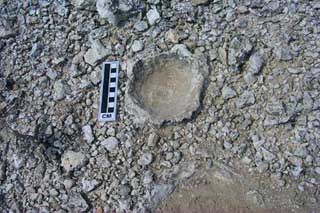
Juvenile
Mastodon track on Elephant Hill (Source:
http://www.psiaz.com/Schur/azpaleo/fosadv/eletrk.jpg)
Other websites and information
on trackways
Miocene carnivore footprints
from Spain -
LÓPEZ, G., MAYORAL,
E., MUÑOZ, A., PÉREZ, A. & SANTAMARÍA, R. (1992).
Nuevas icnitas de mamíferos carnívoros en el Mioceno inferior
del sector occidental de la depresión del Ebro (Logroño,
La Rioja). [New Lower Miocene footprint of the Carnivorous Mammals in
the Western Sector of the Ebro Basin (Logroño, La Rioja)]. Rev.
Soc. Geol. España. Vol.5; 39-53.
Tom Williamson and Gary are
documenting a Miocene trackway that includes tracks of camels and a
large carnivore from the Santa Fe Group near Rio Rancho, New Mexico
(Society for Vertebrate Palaeontology News Bulletin, no.163).
An
Overview of Dinosaur Tracking (also mirrored here)
(1994) by Glen J. Kuban. Originally published in: M.A.P.S. Digest, Mid-America
Paleontology Society, Rock Island, IL.
A
unique Theropod trackway
Dinosaur
trackways - Brooklyn College, City University of New York.
Dino Park - see the dinosaur
tracks in this museum located in Munchehagen, Germany
Glen
Rose Trackway - a series of fossilized dinosaur footprints left
some 107 million years ago at the edge of a lagoon. Excavated from the
bed of the Paluxy River, near the town of Glen Rose in central Texas.
Hominid
trackway at Laetoli and Archaeologist
help unroot hominid prints
Horton
Bluff trackway, Novia Scotia
Jobaria
and the elephant - (also as pdf
file version - 604 Kb) - about some experiments made with a modern
African elephant called Angus to help understand the anatomy of a sauropod.
While working with Angus, Dr. Sereno and Jeff Ogradnik noticed that
the sole of the forefoot was much larger than the sole of the hind foot.
The difference was nearly 1.5 times - the same difference they measured
for the weight of the limb supported. To see a picture of the difference
in size between the prints click
here.
Lark
Quarry dinosaur trackway - Australia
Nashville's
Sauropod trackway
Remembering
Red Fleet and the dinosaur trackway
Sante
Sana Trackway - 250 million year old footprints
Trackway
site shows dinosaurs on the go
- the first recognised evidence of urination in dinosaurs!
Trackways
and Migration: Trackway Speeds
300
Million year old Amphibian tracks
home
|










